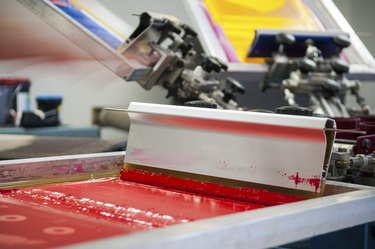
Screen printing is the process of forcing ink through a screen with a stencil blocking off desired areas. Print companies and do-it-yourselfers use screen printing to reproduce designs on various surfaces, such as fabric and plastic. Also known as silk-screen printing, screen printing is one of the many printing techniques available. Before you venture into a project that involves screen printing, you should consider the advantages and disadvantages of this process.
Better Quality That Lasts
Video of the Day
One of the main advantages to screen printing is the vivid results it creates. The overall print quality of screen printing is generally considered higher than other types of printing. Furthermore, screen printing is a versatile printing option that works well on various objects and materials. On garments, the heat-dried ink used in screen printing is tough enough to handle repeat washings without fading or cracking.
Video of the Day
Varying Price Range
Several factors affect the price of screen printing, and you should consider each aspect beforehand. Screen printing items yourself is generally a cheaper option when weighed against other home printing methods. However, when you hire a professional company to perform the task for you, the price can be a bit high, especially for small orders. This is usually due to a setup fee that the company charges in order to prepare the screens for printing the various colors. Screen printing is typically less expensive for larger orders.
Difficult to Reproduce Photos
Screen printing can be a time-consuming project that allows for only one color to be printed at a time. Furthermore, the results when reproducing a photo can be less then desirable. In order to achieve good photo reproduction, a skilled artist must modify the photo and reproduce it onto the screens. DTG (direct to garment) is generally considered better then screen printing for reproducing photos. This is because the digital reproduction has the ability to resemble the original photo better than the results achieved through screen printing.
More Equipment Needed
Screen printing requires several pieces of equipment that will need replacing and upkeep. Ink, screens and emulsion fluids, for example, are all required to properly complete the screen printing process. This additional equipment usually means a higher cost for the consumer. For example, a design with multiple colors will cost more than a design with only one color because of the added cost to make different screens. Furthermore, the screens used in the process can warp, become damaged and require replacement over time.